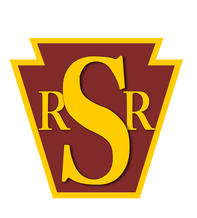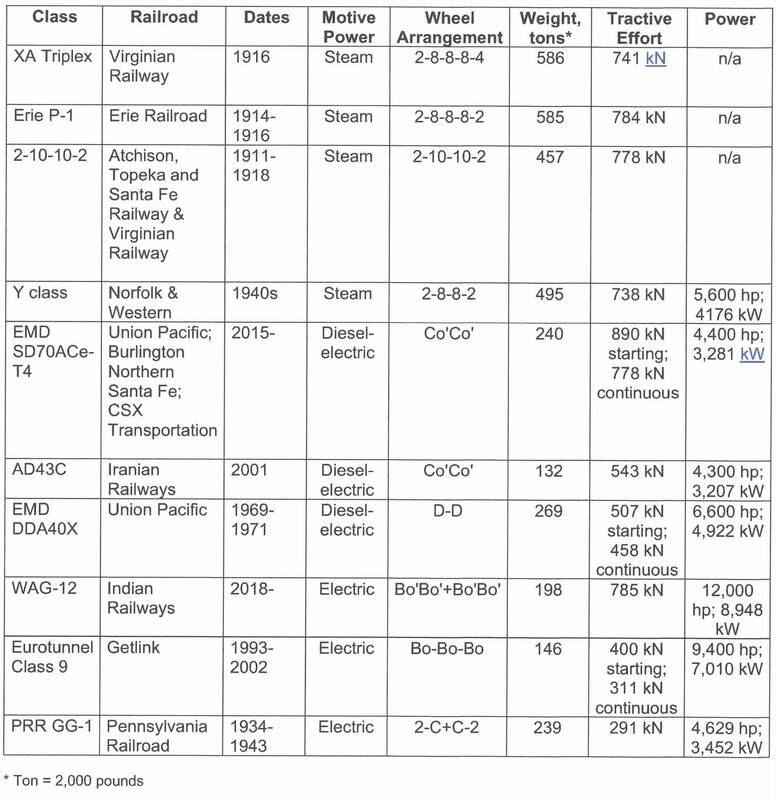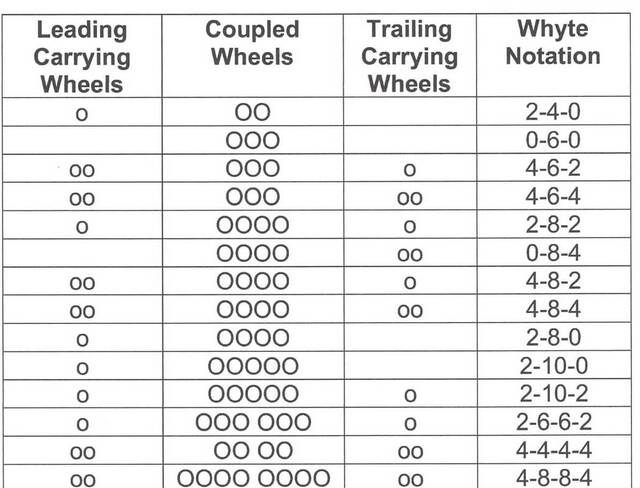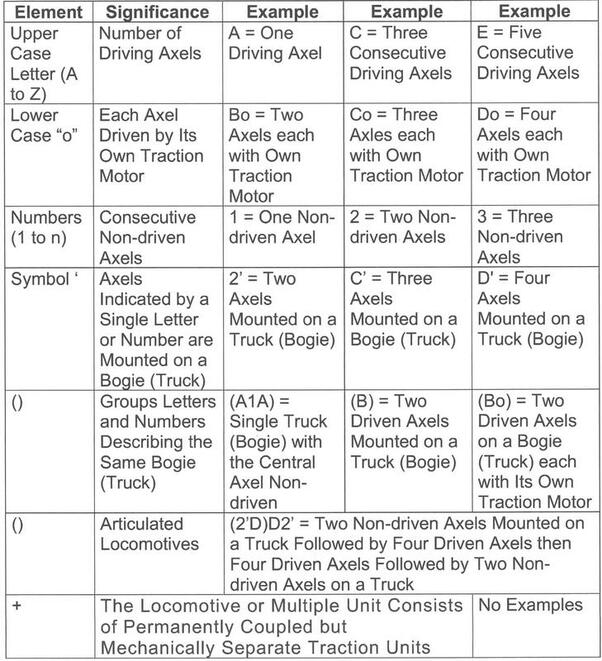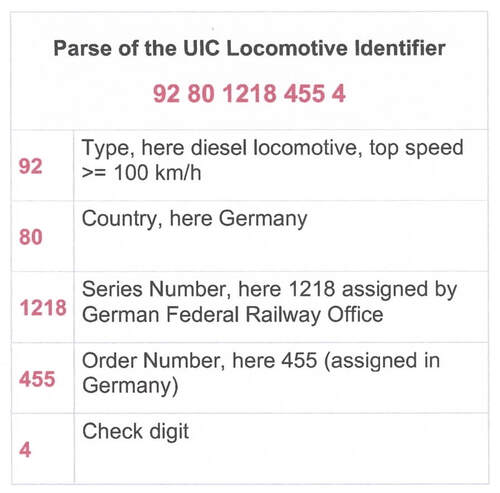Education - Part 5A3
Motive Power - Classification
Motive Power - Classification
Classification of Motive Power
For all practical purposes, there are three classes of motive power, namely steam, diesel and electric. The fuel for steam locomotives can be anything that burns at a high enough temperature to convert water into steam. Although coal has been most common, wood, oil and other fuels have been used.
Fuel for diesel locomotives is diesel oil. While there have been constructed diesel locomotives in which the diesel engine directly drives the axels of a locomotive, virtually all diesel locomotives today are actually diesel-electric. In such locomotives, the diesel engine drives a generator or alternator that provides electrical energy to the axels through electric motors. For our purposes, only diesel-electric locomotives will be considered.
Fuel for electric locomotives may be fossil fuels (coal, oil, gas), nuclear energy, hydropower, hydrogen fuel cells, wind power, or solar power. Batteries have been used in situations where wired electrical transmission is unavailable such as in maintenance of overhead catenary lines (when they must not be powered) or in situations where other power would be hazardous (e.g., mines). Battery-powered trains may become more important as storage and charging capacities improve and as environmental concerns are taken more seriously (see Other Motive Power, a bit later).
The following table gives the motive power of selected locomotives.
Other Classifications of Locomotives
We just discussed one method of locomotive classification: power source. Two other methods of classification are perhaps equally important.
Wheel or Axel Arrangement Denotation Systems
Different systems for denoting wheel or axel arrangements have been developed in various countries. We describe the two most common systems.
We just discussed one method of locomotive classification: power source. Two other methods of classification are perhaps equally important.
Wheel or Axel Arrangement Denotation Systems
Different systems for denoting wheel or axel arrangements have been developed in various countries. We describe the two most common systems.
The Whyte System of Classification of Locomotives
In the United States (US) and United Kingdom (UK) it is common to refer to a steam locomotive wheel arrangement numerically, first by the leading carrying wheels, then the coupled wheels (including the driving wheels) and finally the trailing carrying wheels, in a system invented by Frederick Methvan Whyte in the US in 1900. Examples are given in the following table.
In the United States (US) and United Kingdom (UK) it is common to refer to a steam locomotive wheel arrangement numerically, first by the leading carrying wheels, then the coupled wheels (including the driving wheels) and finally the trailing carrying wheels, in a system invented by Frederick Methvan Whyte in the US in 1900. Examples are given in the following table.
A list of US wheel arrangements is available here on the Wes Barris US Steam locomotive site.
Some European railways used the Whyte system except that the number of axles was used rather than the number of wheels, 4-6-2 becoming 231. This was further developed by the French who used numbers for non-driven axles and letters for driven axles, thus 2C1. Today, axel arrangement is specified using the UIC System.
Some European railways used the Whyte system except that the number of axles was used rather than the number of wheels, 4-6-2 becoming 231. This was further developed by the French who used numbers for non-driven axles and letters for driven axles, thus 2C1. Today, axel arrangement is specified using the UIC System.
The UIC System of Classification of Locomotives
The UIC system of classification of railroad locomotives is managed by the International Union of Railways (UIC: Union Internationale des Chemins de fer). There are two UIC systems to consider.
The UIC Classification of Locomotive Axle Arrangements
This classification scheme describes the axel arrangement of locomotives, multiple units and trams. Note that an axel in this context always implies two wheels. The UIC axel classification system is widely used world-wide, with notable exceptions being the United Kingdom, which uses a slightly simplified form of UIC (except for steam locomotives and small diesel shunters, where Whyte notation is used), and in North America, where the Association of American Railroads (AAR) wheel arrangement system (essentially another simplification of the UIC system) is used to describe diesel and electric locomotives; Whyte notation is used in North America only for steam locomotives.
The UIC axel classification scheme uses the structure defined in the following table.
The UIC system of classification of railroad locomotives is managed by the International Union of Railways (UIC: Union Internationale des Chemins de fer). There are two UIC systems to consider.
The UIC Classification of Locomotive Axle Arrangements
This classification scheme describes the axel arrangement of locomotives, multiple units and trams. Note that an axel in this context always implies two wheels. The UIC axel classification system is widely used world-wide, with notable exceptions being the United Kingdom, which uses a slightly simplified form of UIC (except for steam locomotives and small diesel shunters, where Whyte notation is used), and in North America, where the Association of American Railroads (AAR) wheel arrangement system (essentially another simplification of the UIC system) is used to describe diesel and electric locomotives; Whyte notation is used in North America only for steam locomotives.
The UIC axel classification scheme uses the structure defined in the following table.
The following suffixes may be used with the above scheme to further refine a classification:
- h: superheated steam
- n: saturated steam
- v: compound
- Turb: turbine
- number: number of cylinders
- t: tank locomotive
- tr: tram (urban) locomotive
- E: Engerth-type locomotive
- G: freight
- P: passenger
- S: fast passenger
The UIC System of Identifying Locomotives
In addition to axel arrangement, the UIC system is used to identify a locomotive irrespective of axel arrangement. This system provides a unique identifier for every locomotive within its sphere of influence. The system is called the UIC Identification Marking for Tractive Stock (UIC ID Mark).
The UIC locomotive identifier is a 12-digit number that may be displayed as plain text, as a barcode or as a Quick Response (QR) Code.
The UIC locomotive identifier is structured as shown in the flowing illustration:
The International Block consists of two parts, a type code and a country code. The type codes, ranging from 90 to 99, specify a type of locomotive (e.g., 91 = electric locomotive; 92 = diesel locomotive). The country code is a two-digit number that specifies the country to which the identifier pertains. Spain, for example, has the country code 71.
The National Block consists of two parts, a series number and an order number. The series number (4 digits) is assigned by the country of ownership and thus varies by country. The order number (3 digits) is a serial number within a series, also assigned by the country of ownership. The country code distinguishes otherwise duplicate numbers.
The final digit is a check digit used to insure uniqueness of the complete identification mark. It is computed via an algorithm developed by H. P. Luhn spectrum.ieee.org/hans-peter-luhn-and-the-birth-of-the-hashing-algorithm.
An example UIC locomotive identification mark is shown and parsed below. The precise format of the number is immaterial so long as the order of digits is not altered.
The National Block consists of two parts, a series number and an order number. The series number (4 digits) is assigned by the country of ownership and thus varies by country. The order number (3 digits) is a serial number within a series, also assigned by the country of ownership. The country code distinguishes otherwise duplicate numbers.
The final digit is a check digit used to insure uniqueness of the complete identification mark. It is computed via an algorithm developed by H. P. Luhn spectrum.ieee.org/hans-peter-luhn-and-the-birth-of-the-hashing-algorithm.
An example UIC locomotive identification mark is shown and parsed below. The precise format of the number is immaterial so long as the order of digits is not altered.
A reporting mark or Vehicle Keeper Marking (VKM) is also assigned to every piece of rolling stock to identify the owner or leesee, as appropriate. In North America, the VKM or Reporting Mark is assigned by Railinc Corporation. Examples of such identifying marks may be found in the tables of Class I and Class II railroads presented earlier. In the United States, rolling stock is identified by the Reporting Mark, followed by a number of 1-6 digits. For example, UP 23452 identifies an un-powered car owned by Union Pacific Railroad (UP). The number does not necessarily represent the total number of cars owned or leased by a Reporting Mark.
We turn next to a discussion of the major types of locomotives based on type of motive power: steam, diesel fuel and electric energy.
